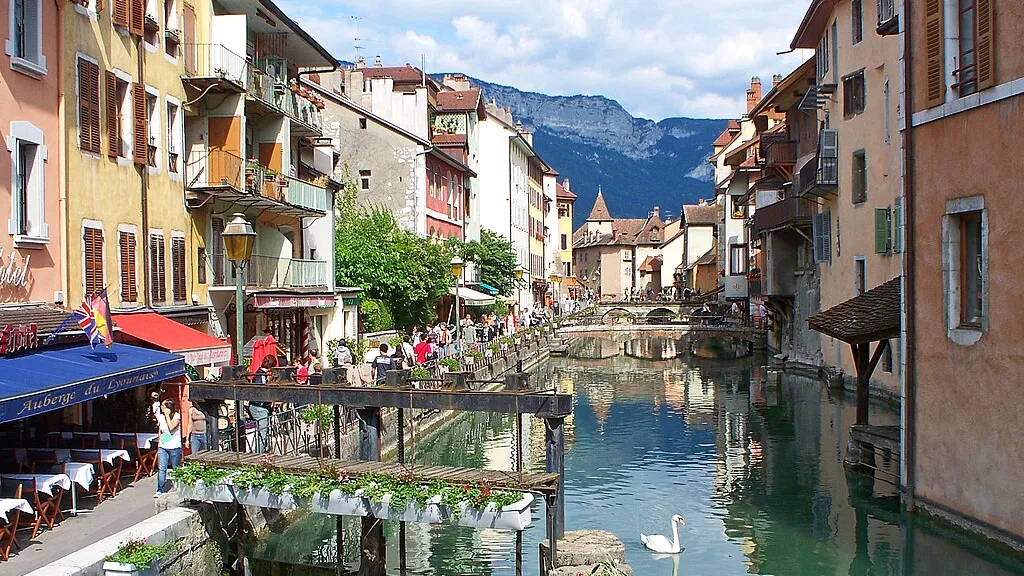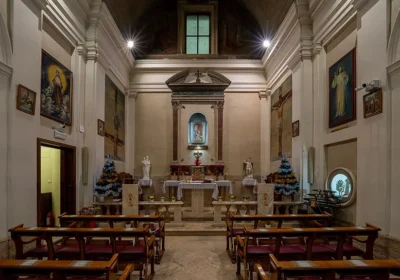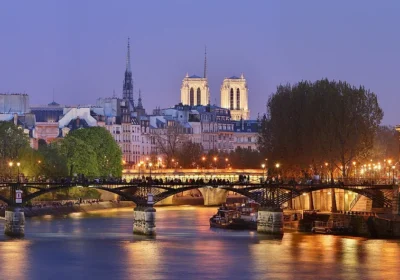Annecy is a city where there is no bad mood, a city by the cleanest lake in Europe.
One view of this corner of France can fill the souls of travelers with pleasure and harmony, cheer you up if you are tired or heal your stress and depression. Snow-capped mountain tops are reflected in the mirror-like surface of the lake.
Opposite these Alpine ranges on the shore is a medieval town with winding streets and romantic bridges over the waters of the rivers and canals running throughout the town.
The castle on top of the hill around which the town has sprouted looks enchanting. When you enter it from the side of the walkways along the lake, you are met by another castle-fortress, like a ship frozen in the middle of the river.
Not only the castle, but also the houses along the canals grow out of the water without embankments or any other structures protecting them, maybe that is why Annecy is compared to Venice. The water comes right up to the houses, reflecting their individuality in its sky-blue surface.
The architecture of the castles and houses is intriguing, both frightening and beckoning at the same time. What is their secret? Undoubtedly, by lifting the veil of history, you will find it out. And the story is not an easy one…
The large number of rich churches catches the eye.
In the 16th century, Catholicism is in crisis. From the east comes a new religious movement – Protestantism. In the neighboring city of Geneva was located the hearth of the Reformation – so called this period of separation of the two branches of the church.
Surprisingly, this new trend was the cause of more than a dozen religious all destructive wars throughout France, while in Annecy (Annecy) the strengthening of Catholicism in the fight against the Protestants took a constructive character, which explains the number of churches and monasteries.
The small provincial town becomes a religious center surrounded by monastery buildings, church institutions and schools, as well as new cathedrals and churches. Gothic is no longer in vogue, so neo-Gothic buildings are built. Alpine Venice was immersed in holy waters. The old town was crowned with domed churches rising above the fortress bastions.
A few centuries later, in a few weeks, the revolution would confiscate all the patrimony of the church, dissolve the monasteries, and destroy the bell towers and temples. Good monastery buildings, also confiscated by the state and sold to industrial trappers, will turn into manufactories.
And what follows is downright scary and creepy. Industrial progress had polluted the lake to such an extent that the birds stopped coming. It was an ecological disaster.
For the first time in French history, there was an alarm and a call to save natural resources. All manufactories were closed. The lake was successfully cleaned in several stages and a reserve was organized on the southern side. Now it is the cleanest lake in Europe, with protected natural areas and the region, as well as its capital Annecy, earns almost exclusively from tourism. Fortunately, there was no irreparable catastrophe, and there is good without good. Today land in Annecy costs more than in Paris. The locals are always happy to see tourists, but they hold demonstrations against the Olympic Games, whether they are afraid of losing their peace, or bitter experience keeps them from mass events.
The Count’s castle today houses an observatory, where you can get to know (even without language skills) the people of the region and their “art of living” (L’art de vivre). And in the quiet little harbor, tucked away in a maple avenue, a charming bridge, as well as many other things, allows you to enjoy the beauty of the waters and the grandeur of this quiet corner in the mountains near the lake. This charm attracts romantics, who have dubbed it the Lovers’ Bridge.
Along the lakeside paths, pleasure boats are moored waiting for water enthusiasts, or you can rent a yacht or a boat for your own adventure. For those who like to dive, there is a base for snorkelers and a beach where everything is simple and clean.
Chateau Montrottier is the castle of the Counts of Geneva.
Built in the period of XII-XV centuries, the castle is located on the slope of a steep hill and rises above a huge cleft made in the mountain by the turbulent river Fier (Fier).
The castle once controlled an important crossing point and its medieval towers loom menacingly over the surrounding landscape. The castle’s last owner bequeathed it to the local municipality to preserve it as a museum.
Today, the former Monttrottier castle houses a magnificent collection of weapons, faience, porcelain, glass and Flemish tapestries. Next to the castle of Monttrottier ten kilometers west of Annecy is the Gorges du Fier gorge (Gorges du Fier). In the gorge itself back in the XIX century were hung bridges, on which tourists walk, admiring the gushing water below. The gorge is deep – in some places up to thirty meters, and the bridges hang at a height of fifteen meters.
You can get into the gorge, inside which the river flows, here you can watch how the river, flat at first, falls then to the bottom of a huge karst fault (its length is three hundred meters and depth – more than seventy), and at the exit of the gorge the river flow forms a bizarre pile of giant stone blocks, called the “Sea of Rocks”. On the surface of the surrounding walls, the play of light and shadows awakens the imagination.
Alternatively to the castle and the gorge, there is a sporting offer for lovers of aquatic pleasures – the town of Sévrier on the western shore of Lake Annecy – a city of water sports and sailing champions and championships. Hair in the wind, the dazzling beauty of the landscape around you… You will be taken for a ride by a professional on a sailboat, revealing the most interesting corners of the alpine lake. During the voyage you can learn to sail or at least appreciate this sport not as an observer. A few trials of balancing the vessel and a few maneuvers by your efforts under the guidance of a coach. And the result? Relaxation and enjoyment under the splash of the water to the rhythm of the walking wind.
Menton-Saint-Bernard Castle, eight kilometers from Annecy, on the eastern shore of Lake Annecy, fortified and repeatedly rebuilt. Its majestic appearance is noticeable from afar. Here travelers from Geneva to Italy found shelter and protection.
It is an antique dwelling where the famous Savoy family still lives today. The current owner of the chateau, Count Manton, keeps the history of the family, knows the names of about 50 generations, although there are many more in the known history of the family. The wealthy and powerful Manton family, which means “on the rock” in Celtic, owned the territory from this very site to Geneva since the XII century. The construction of a castle with a huge tower and living quarters for the liege lords began in that era. Unaffected by either religious wars or revolutionary destruction, the buildings stood for several centuries, taking their time to change their appearance from a fortress-like structure to the more elegant look of a Savoyard castle.
The delicate combination of the landscaper’s and architect’s imagination has created a unique place where all sorts of handmade works of art have taken their rightful place in this exquisite garden.

















